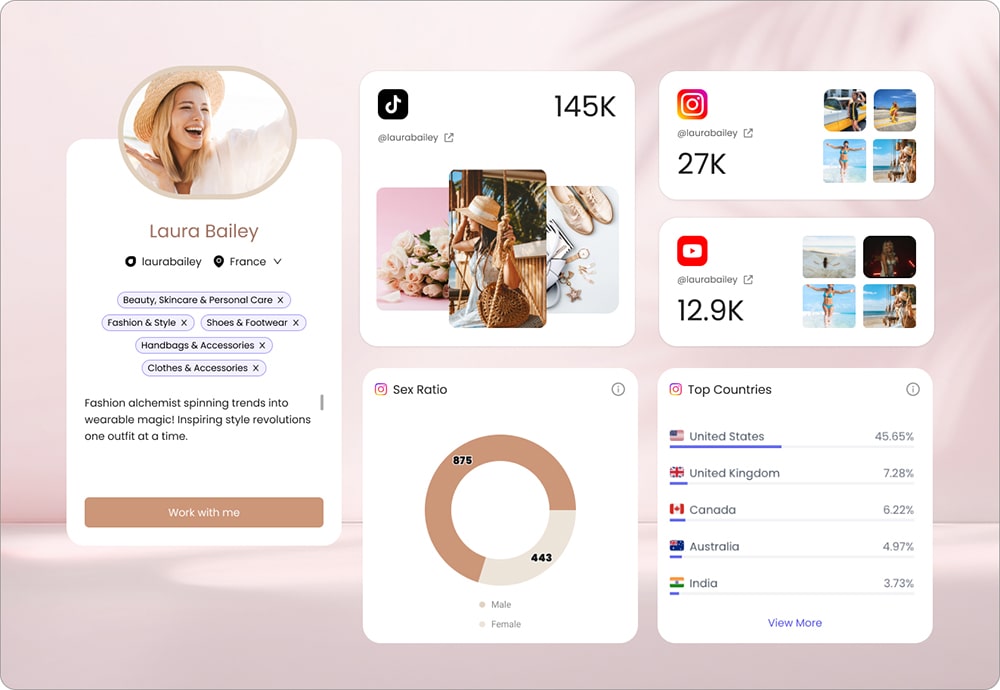Influencer marketing is one of the fastest-growing and most effective advertising strategies of today. So much so, that around 50% of Gen Z shoppers make an incentivized purchase triggered by influencer endorsement. Brands were quick to catch on to the trend, and the number of businesses working with influencers grows by the minute.
As more and more businesses start working with influencers to promote their products, one of the biggest challenges they face is calculating the return on investment (ROI) of their influencer marketing campaigns to determine how effective they were. Because influencer marketing campaigns usually require brands to allocate a considerable budget, it becomes significantly important to measure correctly whether the investments are paying off.
This article takes a look at how brands can accurately calculate their influencer marketing ROI and what factors should be taken into account when calculating campaign costs and results.
Creating goals before starting Influencer Marketing
Influencer marketing can do wonders for your brand. In 2020, 60% of marketers thought that influencer marketing had a greater ROI than traditional advertising. However, it’s important to have clear goals before you start your campaigns. Without a clear KPI in mind, you won’t be able to derive credible information about the performance of your campaigns as you start running them.
The KPIs of your influencer marketing campaign will vary depending on what you are trying to achieve. Usually, influencer marketing campaigns have two goals: conversions and brand awareness. These goals will then inform how you construct your influencer marketing campaign and how you measure its performance.
Conversions
In influencer marketing, conversion is often the golden standard for measuring the effectiveness of any campaign. For influencer marketing, similar to social media marketing, posts contain a clear Call-to-Action (CTA), urging the viewers to take a specific action. Depending on your product or campaign aim, CTAs may include sign-ups, sales, app downloads, and more.
Sign-ups
Sign-ups are one of the more common conversion goals for influencer marketing campaigns and have some of the most easily measurable ROIs. While typically associated with registrations on a website, sign-ups can also be to events (to your local pop-up store), newsletters (your skincare monthly newsletter), webinars, and whatnot. Sign-ups usually involve the user providing personal information, such as their name, email, phone number, and other data, and usually consenting to be contacted by the brand in the future.
Sales: Online and offline
Businesses should make a profit, and sales are probably the most important success criteria for any campaign. You can analyze the sales performance of your influencer marketing campaign by taking a look at:
- How much money was spent on the campaign, and how much was the revenue brought by the purchase as a result
- The average value of the orders
- The number of new customers who made a purchase
- What is the lifetime value of the customers (e.g. in the case of subscription products)
By comparing the cost with the purchases and future purchase predictions, you can measure the return with greater nuance
App downloads
If you’ve taken the time to build a mobile application, app downloads are another KPI you should be measuring. App downloads are an especially popular KPI for B2B companies, online retailers, and mobile game development companies. Similar to sign-ups, mobile app downloads are fairly straightforward to measure. Once you’ve increased your downloads, focus on enhancing user engagement to prevent users from deleting the app over time. To measure these metrics accurately, ensure you have well-developed tracking systems in place. Consider hiring an app developer to install these tracking mechanisms
Brand awareness

Brand awareness is another primary goal of influencer marketing campaigns. Working closely with influencers who have a large engaged following allows us to significantly increase visibility and reach new audiences. When calculating the influencer marketing ROI for brand awareness, here are the metrics you need to consider.
Engagement: likes, shares, and comments
The engagement with the content in the form of likes, shares, and comments not only shows the interest of the users but are also counted by the algorithms of some social platforms, increasing the post visibility. Like, shares and comments as engagement metrics can slightly vary from channel to channel, e.g. YouTube values likes and comments, while Instagram has started to pay more attention to saves. However, these engagement metrics on all platforms show how many people interacted with your content, and (hopefully!) indicate positive social sentiment.
Reach
You are looking to see how far your content can go on the Internet, and reach shows just that! It can indicate the number of times your YouTube video was watched or how many unique people saw the post on Instagram, including in the feed, discovery page, or through search. Reach is an important ROI for businesses, showing how many people are seeing their content compared to the total audience size. It can also help identify new opportunities by showing which type of content spreads better.
Traffic
Social media traffic refers to the number of visitors who visited your website from a social media platform and can include users coming through organic links or social ads. In the case of influencer collaboration, an increase in social media traffic can indicate the right fit of partners and the effectiveness of the chosen strategy.
Calculating influencer marketing costs

To accurately measure your influencer marketing ROI, you need to first calculate the cost of your influencer marketing campaign. This can vary significantly depending on whether you handle the campaign in-house, turn to an influencer marketing agency, or use an influencer marketing platform. Each of these options includes real and hidden costs that should be considered.
In-house Influencer Marketing Costs
Finding the right influencers, getting in touch with them, and organizing collaboration takes many hours of intensive work. When doing influencer marketing in-house, you will have to bear the costs of identifying the influencers through many hours of search, reaching out to the influencers and negotiating with them, creating and managing the content, tracking the metrics, and analyzing the results. In addition to the time spent on organizing and managing the campaign, there is also the financial side to consider. Additional costs will include:
- Influencer fees, which they will charge depending on their size, content type, and post frequency
- Fees associated with content creation, such as outfits, makeup artists, additional talent, and more
- Product cost, if you are sending products to the influencers to feature
- Employee salaries
- Tools and software used for campaign management.
- Potential legal fees for developing and signing contracts
In-house influencer marketing campaigns can initially seem costly and time-consuming, however, it comes with many benefits, allowing larger creative and operational control over the process, and allowing adjusting the campaigns to the brand’s specific needs more easily.
Influencer Marketing Agency Costs
Influencer marketing agencies specialize in providing full-circle services, from finding the right influencer to managing the metrics. The cost of influencer marketing agencies will typically include
- A retainer, monthly or annual depending on the contract
- The influencer fees
- Possible additional costs for creative development and analytics
However, the final cost of the campaign will depend on its size and the specific services clients need. Working with an influencer marketing agency can be costly, but it can help save time and resources. Some of the benefits of working with an influencer marketing agency:
- Saved time – influencer marketing agencies have experience with effectively running and managing an influencer campaign.
- Lower influencer rates – Influencer agencies have worked with numerous influencers in various niches, and have cultivated a close relationship with them, which helps them to secure lower rates.
- More informed campaigns – Based on their previous experience working with influencers, agencies can select influencers based on existing data on their performance in various niches.
Influencer Marketing Platform Costs
Influencer marketing platforms provide an easy and streamlined way to find and contact relevant influencers, thus cutting down on resources needed to run a successful campaign. These are platforms that help brands looking for creators to make announcements, and get in touch directly with the influencers matching their needs. When using an influencer marketing platform, costs can include
- The cost of the platform, which will vary depending on their charging strategy
- Possible additional costs for the analytics and content creation
- The influencer fees
- Product fees
The costs can significantly vary depending on the tools used, your campaign needs, as well as what kind of influence you’re looking to work with, and their reach and engagement.
Overall, the cost of influencer marketing can vary widely depending on your needs and approach. To calculate the ROI of your influencer marketing campaign, it’s important to have a clear idea of your approximate budget and expected costs to later have informed and accurate performance data.
ROI Formula

The ROI formula is a way to measure the effectiveness of an influencer marketing campaign. To accurately calculate the ROI of an influencer marketing campaign, it’s important to know the cost and value of the campaign.
The cost of the campaign
To understand the cost of the campaign, start adding up all the costs that went into the campaign. This can include influencer fees, content production expenses, possible legal expenses, and all the other costs. For recurring costs, such as software subscriptions, divide the monthly bill over the duration of the campaign and for how many campaigns it was used.
The value of the campaign
The value of the influencer marketing campaign is its outcome over a defined amount of time, say, one month. It can include sales, sign-ups, engagement rates, and website traffic.
Once you have this data, your influencer marketing ROI can be calculated using the following formula:
ROI = (Revenue generated from influencer marketing campaign – Cost of the influencer marketing campaign) / Cost of the influencer marketing campaign
This formula is a good place to start when calculating your influencer marketing ROI. However, in reality, getting the accurate number is more complicated, as there are other variables to consider, such as the long-term impact and brand awareness. The data can also vary greatly depending on your campaign goal. This being said, having clear goals and tracking relevant metrics can give you a good sense of return on your influencer marketing investment.
Tools to Calculate ROI
To calculate influencer marketing campaign ROI, you need to access the campaign performance data through relevant tools. It’s recommended that you do both qualitative and quantitative research.
- Qualitative research – Numbers don’t show sentiment: most social platforms are indifferent to the emotions driving engagement. For Instagram, a comment is a comment. That’s why, to understand how people feel about your brand, you need to do qualitative research. For smaller campaigns, a manual approach will work. For large campaigns, you can use third-party sentiment analysis and social listening tools.
- Quantitative research – This is the part, where you crunch the numbers. This means accessing data through analytics tools, and using the formula above to calculate the ROI of your campaign.
Here are several tools you can do for the quantitative part of your ROI analysis.
Social media analytics tools
Each social platform comes with analytics tools, offering details insights into the performance of your campaigns. In addition to native analytics tools, there are many third-party analytics tools available to measure campaign performance across various channels. Third-party tools like Buffer or HootSuite, in addition to allowing social scheduling, provide valuable analytics.
Specialized influencer marketing tools
If you are working with influencer marketing platforms, they might offer you special campaign performance-tracking tools and analytics information you can use to calculate your ROI more effectively.
Web analytics
Web analytics tools are especially important if your campaign aim is to drive traffic and generate conversions. Here, Google Analytics is a powerhouse, offering a colossal amount of detailed data about the traffic amount, visit duration, custom URLs, and much more for free. Other web analytics options include Semrush and Adobe Analytics.
Custom links and promo codes
Another way to track the performance of your campaigns is by providing influencers with unique links and promo codes. This is a fairly straightforward method, allowing you to easily attribute purchases or visits to creators driving them. A good practice is to offer discounts through promo codes, and the custom UTM links can then easily be tracked through web analytics tools.
Dedicated landing pages
For large campaigns with big influencers, you can create dedicated landing pages tailored specifically to the audience of a specific creator. Though slightly resource-consuming to make, dedicated landing pages significantly simplify the process of calculating the campaign ROI.
ROI calculation example

After you finally know what your campaign cost and campaign value are, it’s very simple to calculate the ROI of your influencer marketing campaign. Here’s a sample calculation of an influencer marketing campaign ROI:
- A skincare brand pays the influencer with 200,000 followers $1000 to post a photo of their newly-launched moisturizer
- The influencer’s post is seen by 100,000 people and generates 5,000 clicks, of which 1,000 people use the influencer’s discount code to make a purchase, generating $20,000 in sales
Here, the campaign cost was $1,000, while the value of the campaign was $20,000
ROI = ($20,000 – $1,000)/$1,000 = 19 (or 1900%)
So, in this example, the influencer marketing ROI was 1900%, meaning for every dollar spent, the brand received $19 in return
Conclusion
Influencer marketing is a highly effective marketing strategy, which has become loved by marketers and brands worldwide and reportedly helps them generate as much as 11X banner ad ROI. However, to ensure that it works for you. Make sure to continuously calculate your campaign ROI, analyze what works and what doesn’t, how each influencer and post type performs and adjust your campaigns accordingly. Cooperate with different influencers, do A/B testing, try out different social platforms, and in the end, choose what works. This way, you’ll maximize your ROI over time, and make your influencer marketing campaigns increasingly more profitable.
Reviewed By Rem Darbinyan
Revolutionizing industries with AI, Rem Darbinyan is the CEO of ViralMango and an entrepreneur, AI expert, and influencer marketing strategist.




